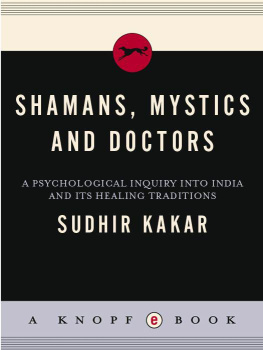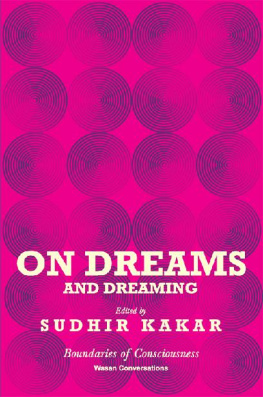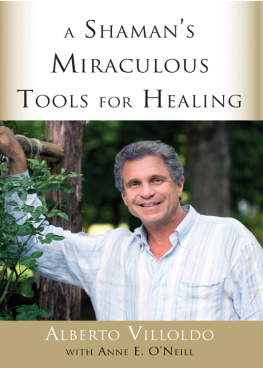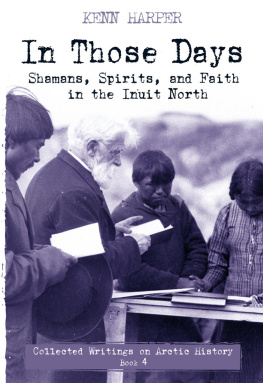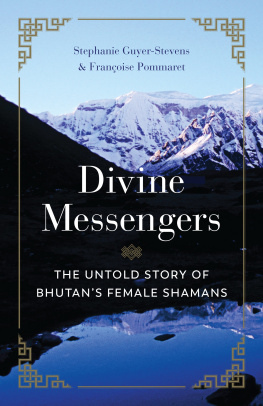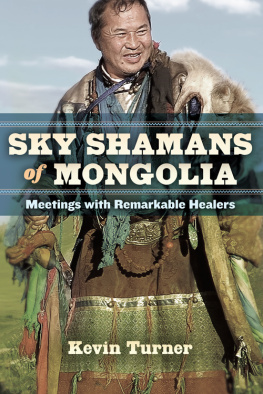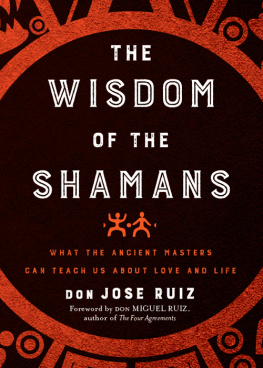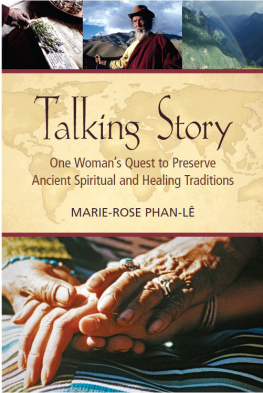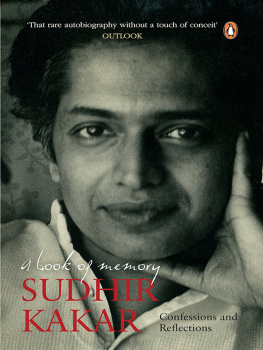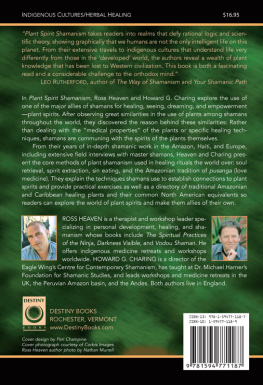ALSO BY SUDHIR KAKAR
Frederick Taylor:
A Study in Personality and Innovation
(1970)
The Inner World:
A Psychoanalytic Study of
Childhood and Society in India
(1978)
Identity and Adulthood
(editor, 1979)
THIS IS A BORZOI BOOK
PUBLISHED BY ALFRED A. KNOPF, INC .
Copyright 1982 by Dr. Sudhir Kakar
Illustrations Copyright 1982 by Susan Gaber
All rights reserved under International and Pan-American
Copyright Conventions. Published in the United States by Alfred A. Knopf, Inc., New York, and simultaneously in Canada by Random House of Canada Limited, Toronto. Distributed by Random House, Inc., New York.
Library of Congress Cataloging in Publication Data
Kakar, Sudhir.
Shamans, mystics and doctors.
1. Mentally illCare and treatmentIndia.
2. HealingIndia. I. Title.
RC 451.14 K 34 1982 616.8900954 82-47806
eISBN: 978-0-307-83179-8
AACR 2
v3.1
For my sister, Suleena,
in memory of our parallel
yet shared childhoods.
CONTENTS
2 Soul Knowledge and Soul Force:
The Pir of Patteshah Dargah
8 Indian Medicine and Psychiatry:
Cultural and Theoretical Perspectives on Ayurveda
ACKNOWLEDGMENTS
T he study on which this book is based was made possible by the grant of a Homi Bhabha Fellowship. I am grateful to the Fellowship Council and its honorary director, Narayana Menon, for their generous support. My student and friend Ashok Nagpal, who shared my enthusiasm for the project and worked closely with me through its many phases, was of immense help with the fieldwork, especially with the healers of local and folk traditions. He is the second part of the we and the colleague referred to in the text, and my debt to him is great.
Parts of the book were presented at the Mind and Society Seminar of the Centre for the Study of Developing Societies, the research seminars of the Department of Indian Studies and the Psychosocial Group at the University of Melbourne, the South-Asian Seminar at the University of Chicago, seminars of the Departments of Psychiatry of the San Francisco Childrens Hospital, Parkville Psychiatry Unit, Melbourne, and the Royal Childrens Hospital, Melbourne. Without being able to list specific individuals, I am happy to acknowledge my debt to the discussants who helped me to clarify many puzzling issues.
The persons I can list, and with great pleasure too, are Wendy OFlaherty and Kim Marriott of the University of Chicago and Don Miller of the University of Melbourne. They gave much of their time in going through the manuscript, were generous with their praise and delight when they came across something that pleased them and were gently but firmly critical whenever they disagreed. There are indeed very few pleasures in the otherwise lonely work of writing that can match the sharing of its product with such perceptive and concerned friends.
I also wish to express my warm appreciation to Lee Goerner at Knopf, both for his enthusiasm for the book and for his editorial skill which made me realize clearly how sometimes less is more.
And finally, my thanks go to Apeksha, Kamla and my father Sardarilal Kakar, all of whom have been a consistent source of love and encouragement over the years.
1

INTRODUCTION
T his book explores the traditions of India that are concerned with the restoration of what is broadly termed mental health in the West. Without going into complicated definitional and conceptual issues, I shall only mention that in the context of this exploration, I do not use mental health as a narrow theoretical conceptthat would indeed be a dubious undertakingbut as a rubric, a label which covers different perspectives and concerns, such as the absence of incapacitating symptoms, integration of psychological functioning, effective conduct of personal and social life, feelings of ethical and spiritual well-being and so on. Drawing on three years of fieldwork, I have tried to describe, analyze and reflect upon my experiences with gurus of mystical cults, shamans, practitioners of ancient systems of medicine and other indigenous colleagues who are also professionally engaged in the common endeavor which the Oxford English Dictionary, in its third entry under healing, defines as to restore (a person, etc.) from some evil condition or affection (as sin, grief, disrepair, unwholesomeness, danger, destruction); to save, purify, cleanse, repair, mend.
The diversity of these traditions in India and the astonishing variety and number of practitioners can make a stranger to the country feel that healingin its manifold aspectsis a central individual and cultural preoccupation, an impression which may not be far off the mark. Like very few other people, Indians have long been involved in constructing explanatory systems for psychic distress and evolving techniques for its alleviation. Besides the few psychiatrists of modern medicine, there are the traditional physiciansthe vaids of the Hindu Ayurveda and Siddha systems and the hakim of the Islamic unani traditionmany of whom also practice what we today call psychological medicine. In addition, there are palmists, horoscope specialists, herbalists, diviners, sorcerers and a variety of shamans, whose therapeutic efforts combine elements from classical Indian astrology, medicine, alchemy and magic, with beliefs and practices from the folk and popular traditions. And then, of course, we have the ubiquitous sadhus, swamis, maharajs, babas, matas and bhagwans, who trace their lineage, in some fashion or other, to the mystical-spiritual traditions of Indian antiquity and claim to specialize (whatever else they might also do) in what in the West in a more religious age used to be called soul healththe restoration of moral and spiritual well-being.
While not exhaustive, an attempt to describe this threefold division of healers does not follow any rigorous categorization, but it does correspond to the general notion that there are three different realms of individual functioning. From the first birth cry to the last breath, an individual exists in his soma, his psyche and his polis; in other words, a person is simultaneously a body, a self and a social being. Of course, the body, the self and the polis do not possess a fixed, immutable meaning across cultures. As we shall see later, the concept of the body and the understanding of its processes are not quite the same in the Hindu Ayurveda as they are in Western medicine. The self toothe Hindu subtle bodyis not primarily a psychological category in India though it does include something of the Western psyche. According to the Hindus, the disturbances in the order of the self, for instance, are not seen to have their genesis in early family connections, but are related to the notion of the workings of karma over the whole of the individuals life cycle as well as across the cycle of his many lives. When we talk of shamans and other healers of folk traditions correcting disturbances in the individuals social order, then we must remember that for many Indians the polis consists not only of living members of the family and the community, but also of ancestral spiritsthe pitrisand other spirit beings who populate the Indian cosmos.
The highly diverse activities of Indian healers share a certain family resemblance in that, as compared to Western psychotherapies, the role of the sacred is more prominent in India. By sacred I mean not only the Brahman of the mystics, the Krishna of the devotees or the gods of the rituals, but also the spirits of ancestors and forests, the beings that live in enchanted groves, the specters that haunt cremation grounds and the demons who wait at the next crossing. It is the sacred that links the guru concerned with the malaise of the spirit to the shaman treating illness due to machinations of the spirits. In practice, therefore, there may be a considerable overlap between the three orientations. It is the introduction of the sacred in the assumptive worlds of the healer and his patient and the areas of the patients

